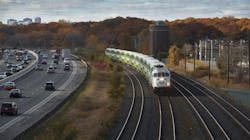How GO Expansion will create a network effect and give transit riders more options
Moving around the Greater Toronto and Hamilton area (GTHA) will be easier than ever with the GO Expansion project delivering more two-way, all-day service to more communities and trains every 15 minutes or better.
It’s an ambitious plan that will include visible changes like faster electric trains, more accessible stations and improvements at Union Station. The plan will rewire the region by making more trips possible on public transit – including journeys out of Toronto.
“In addition to more frequent trips, you will be able to make reverse journeys,” said Spencer Gibbens, Metrolinx’s head sponsor for GO Expansion. “You will be able to get a train to Kitchener or Newmarket for nine in the morning.”
This isn’t just something on the horizon, either. Incremental service increases have already started. For instance, rush hour trains began arriving in Hamilton’s West Harbour GO on Sept. 21, 2021.
A growing regional economy means more people are now commuting into places that used to be seen mainly as starting points for commutes.
“Our stakeholders in Kitchener are excited about the fact that we will get a train into the city before the start of the workday,” Gibbens said. “Tech companies are recruiting skilled workers from Toronto and we must give them a good train service to Waterloo Region.
“With two-way, all-day service we will start to see the Toronto-centric model give way to more people moving in new directions. You will also see people going between places like Brampton and Kitchener, Oakville and Hamilton; it will just become more natural,” Gibbens added.
Some people are already aware of summer weekend service to Niagara, which Gibbens sees as a view into the future.
“Given an opportunity to go in a different direction, people will take it up,” he said. “It’s largely taking people out of Toronto to somewhere else and that’s exactly the kind of choice we are trying to create with a growing network.”
Over the long-term, Gibbens sees more transit connections to come.
“There are some short cuts that we are working to create, especially along the Kitchener corridor,” he explained. “Once expansion is complete you won’t have to go all the way to Union to get to Pearson Airport, instead you will be able to change trains at Weston or Mount Dennis.”
Mount Dennis will also be an important connection between GO and the new Eglinton Crosstown light rail transit (LRT) project, giving people a more direct way of reaching midtown Toronto.
Trains coming every 15 minutes, or more, are an important part of the vision for GO Expansion, and people living on the Lakeshore West and East lines are already enjoying it, at certain times of day
“Most of the time on the Lakeshore lines people don’t have to think about train timetables anymore,” Gibbens explained. “You know that if you just turn up at the station you won’t have to wait more than a few minutes for a train.”
This added convenience is increasing travel options, both into Union Station and to stops along the way.
“In Durham Region, you might not necessarily be commuting into the downtown, but you will go between pairs of stations, Gibbens said. “You can ride from Oshawa, or even Scarborough, to the mall that’s connected to our station in Pickering, without having to worry about a wait between trains.”
This is a new approach for GO – moving beyond commuter trips to provide frequent trains, all day, in a metro-style service. Much like the subway, it will be easier to use GO Transit like the subway to get to events, go out to dinner and visit friends or family in the evening or on weekends.
Reduced time between trains will make for shorter trips. So will faster trains. New electric trains are also part of the GO Expansion plan and they will reach greater speeds than today’s diesel engines. Faster acceleration and deceleration will reduce the time required for each stop.
Ultimately, the combination of cleaner, electric trains and more people using transit will improve air quality in the GTHA.
Improved station design can also make a difference. Platforms at Union Station will be expanded to create more space for people getting off trains, reducing the time it takes to get out.
“Getting through a station smoother and faster contributes to an improved journey,” Gibbens said.
When the Ontario Line subway project is completed, an expanded Exhibition GO Station and a new station at East Harbour will offer faster transfers between GO and the subway, giving riders an option to bypass Union Station. As riders choose the two new transfer points to move from GO to the subway, crowding at Union Station will be reduced.
“These connections will offer a huge benefit to riders using Union Station because people will be accessing the subway at three locations instead of the one today,” Gibbens explained. “This will make for a much easier connection to downtown than we currently have with everyone going through Union Station to Line 1.”
He also pointed to plans for Kitchener that would move the GO stop to a future transit hub at King and Victoria, where it will connect to the new ION LRT, again improving connection times.
These improvements all contribute to the network effect – the idea that a service becomes more valuable as more options become available and the number of customers grows.
